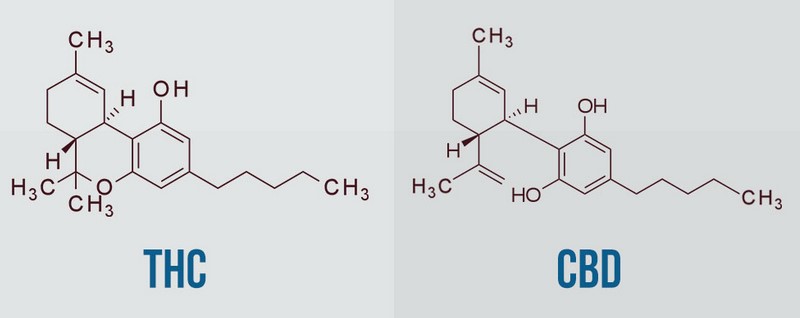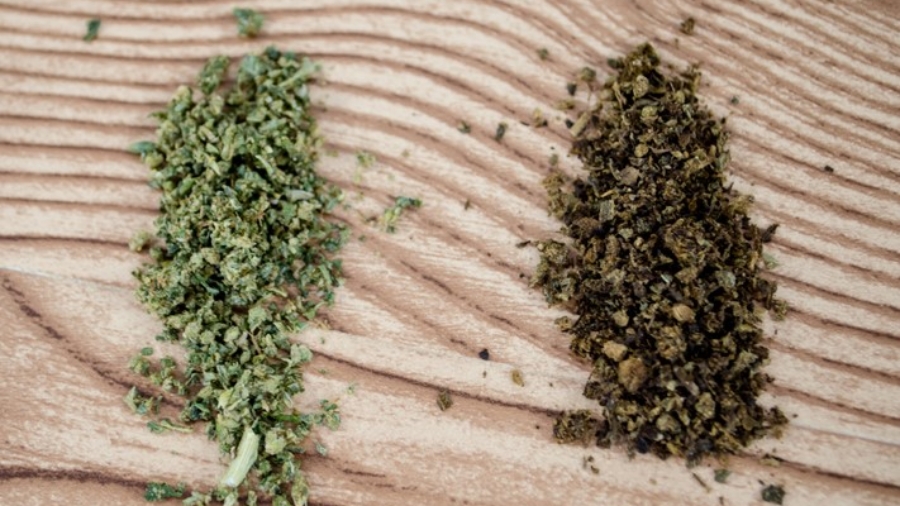Decarboxylation is the process that activates compounds in cannabis such as THC. All cannabinoids contained within the trichomes of raw cannabis flowers have an extra carboxyl ring or group (COOH) attached to their chain. For example, tetrahydrocannabinolic acid (THCA) is synthesized in prevalence within the trichome heads of freshly harvested cannabis flowers. In most regulated markets, cannabis distributed in dispensaries contains labels detailing the product’s cannabinoid contents. THCA, in many cases, prevails as the highest cannabinoid present i items that have not been decarboxylated (e.g., cannabis flowers and concentrates).
THCA has a number of known benefits when consumed, including having anti-inflammatory and neuroprotective qualities. But THCA is not intoxicating, and must be converted into THC through decarboxylation before any effects can be feltDecarboxylation is easy enough to do at home using tools you likely already have in the kitchen. Beyond the basic oven method, here you’ll also find instructions for decarbing in a mason jar and by sous vide, which are excellent alternatives for those concerned about the pungent scent of cannabis cooking.
Causes
The two main catalysts for decarboxylation to occur are heat and time. Drying and curing cannabis over time will cause a partial decarboxylation to occur. This is why some cannabis flowers also test for a presence of small amounts of THC along with THCA. Smoking and vaporizing will instantaneously decarboxylate cannabinoids due to the extremely high temperatures present, making them instantly available for absorption through inhalation.
While decarboxylated cannabinoids in vapor form can be easily absorbed in our lungs, edibles require these cannabinoids present in what we consume in order for our bodies to absorb them throughout digestion. Heating cannabinoids at a lower temperature over time allows us to decarboxylate the cannabinoids while preserving the integrity of the material we use so that we may infuse it into what we consume.
Temperature
The THCA in cannabis begins to decarboxylate at approximately 220 degrees Fahrenheit after around 30-45 minutes of exposure. Full decarboxylation may require more time to occur. Many people choose to decarboxylate their cannabis at slightly lower temperatures for a much longer period of time in attempts to preserve terpenes. Many mono and sesquiterpenes are volatile and will evaporate at higher temperatures, leaving potentially undesirable flavors and aromas behind. The integrity of both cannabinoids and terpenoids are compromised by using temperatures that exceed 300 degrees F, which is why temperatures in the 200’s are recommended.
Heat and time can also cause other forms of cannabinoid degradation to occur. For example, CBN (cannabinol) is formed through the degradation and oxidization of THC, a process that can occur alongside decarboxylation. CBN accounts for a much more sedative and less directly psychoactive experience.
Cannabis can also be decarboxylated in a slow cooker by introducing solvents such as cooking oils or lecithin. These methods create infusions that can be used in a variety of cooking recipes, topicals, and even cannabis capsules. Since they contain decarboxylated cannabinoids, they will be effective any way you choose to consume them.
Decarboxylation is the magic that makes cannabis a potent additive to food.
Simply put, it’s a chemical reaction that is achieved through heating up raw cannabis to a temperature at which it releases a carboxyl group and becomes psychoactive.
THCA (Tetrahydrocannabinolic acid) is the active component in raw cannabis, and it’s not a psychoactive compound by default.
Through decarboxylation, we’re essentially applying heat to plant material so that the THCA gets converted to THC, enabling us to get high.
Chemistry of decarboxylation

Cannabinoids in raw cannabis have an extra carboxyl ring in their molecular structure.
For the purposes of this article, we’ll focus on the two most prevalent: THC and CBD.
This extra carboxyl group gets removed in the process of decarboxylation due to the effect heat has on their chemical structure.
Once enough heat has been applied, the molecule will release a carboxyl group. That carboxyl group then gets replaced with a hydrogen molecule.
This process is pretty much the same for CBD. Both CBD and THC acids are carboxylic acids which tend to decompose directly when heated.
Only complex carboxylic acids decompose under the influence of heat alone.
Decarboxylation chart
As with any other chemical process, there are certain things that need to happen in order for chemical compounds to change their structure.
Decarbing is a process that involves both temperature and time, so it’s all about balancing the two.
Luckily for us, there is a chart for that.
This is called a decarboxylation chart and it allows you to see how you can reach the desired THC by baking the buds on a specific temperature for a set period of time.
As this chart was based on a strain that can reach a maximum of 15% THC, you can see that the easiest way to reach that amount is by baking cannabis in an oven for about 7 minutes at 300°F (148°C)—or for 20 minutes at 250°F (121°C).
How to decarb weed (in 6 steps)
So far, we’ve learned that decarboxylating cannabis is a needed step in making super-potent edibles and that cannabis can be decarbed in several ways, depending on the temperature and the time you bake it at.
We also found out that the easiest way to decarboxylate cannabis is to bake it at a relatively low temperature for about 30 minutes.
Now, here’s a step by step guide:
- Preheat the oven to 250℉. The light should turn off once the oven has reached the temperature.
- Break up your cannabis into small chunks. Don’t grind it, just break it into smaller bits and don’t leave any nugs out.
- Spread the cannabis on a piece of baking paper. Make sure there are no overlapping pieces of cannabis.
- Bake the cannabis at 250℉ for 25-30 minutes. Make sure not to open the oven too often. Decarbed cannabis should change its color from green to light brown.
- After 25-30 minutes, check your cannabis. It should be light to medium brown and should be very dry. If it’s not, put it back in the oven for an extra 5 minutes. Keep an eye on it so it doesn’t burn.
- Remove cannabis from the baking sheet and let it cool for a while. Careful, it’s going to get very crumbly at this point.
How to decarb in a mason jar
Tools
- Mason jar with lid
- Baking tray
- Kitchen towel
- Cannabis
- Oven gloves
Directions
- Set your oven between 220 and 240 degrees Fahrenheit and place the oven rack in the middle position.
- Break up the cannabis until it’s about the size of a grain of rice, put it into the mason jar and lightly screw on the lid.
- Lightly wet the kitchen towel and lay it over the baking sheet then put the mason jar on the towel. The damp towel will help anchor the jar to the baking sheet and keep it from falling over.
- Place the baking tray in the oven and bake for 60 minutes. Every 15 minutes, carefully remove the mason jar from the oven with the oven gloves and give it a shake to disperse the cannabis evenly.
- After 60 minutes, remove the jar from the oven, and let cool for 30 minutes before storing or using it for cooking.
If this sounds complicated, you can always get a Magical Butter machine or the Nova Decarboxylator and skip all of the steps above, as the machine does everything for you in under an hour.
Decarboxylate CBD Strains
Just as you need to decarb your high-THC weed to feel its effects, you’ll also benefit from doing so with your CBD flowers. During the decarboxylation process, CBDA converts to CBD. Although CBDA displays some interesting effects, CBD offers much more well-understood benefits. Before crafting edibles, tinctures, or oils using your CBD buds, make sure you decarb them for the best outcomes.
Decarboxylation Temperature for THC and CBD
Decarboxylation temperatures are largely the same for most major cannabinoids. As mentioned, a temperature of 110°C, sustained for 30–45 minutes, gets the job done.
Boiling Points of Cannabinoids, Terpenes, and Flavonoids
Many cannabis smokers confuse decarboxylation with vaporization (boiling point). Although decarboxylation naturally occurs when vaping, the boiling point of various cannabinoids, terpenes, and flavonoids can differ dramatically depending on the volatility of the phytochemical in question.
Check out the recommended temperature settings below when you feel like vaping your cannabis.
· Cannabinoids
Cannabinoids vaporize at different temperatures, which means vapes with precise settings can target specific cannabinoids. Alter the temperature depending on what kind of strain you’re smoking—you’ll find different settings work better for high-THC vs high-CBD buds.
· Terpenes
Terpenes underpin the delicious and unique flavours of each cannabis strain. Plus, these molecules synergise with cannabinoids to amplify their effects.
· Flavonoids
Flavonoids also complement the complex phytochemistry of cannabis. These molecules are associated with antioxidant effects, among others. Some of them occur all throughout the plant kingdom, whereas others are unique to cannabis.
Decarboxylating Kief and Concentrates
Kief and cannabis concentrates offer a more potent experience than flowers alone. Growers usually collect kief using grinders or sifting trays, meaning the trichomes aren’t exposed to high temperatures during the process. Additionally, some concentrate preparation methods don’t reach the point of decarboxylation.
To ensure maximum potency, we recommend using the same procedure detailed above to decarb your cannabis buds/kief before making these products.
Now, once your cannabis has cooled down sufficiently, you can put it in a food processor and pulse until it’s thoroughly ground (like oregano).
If you’re going to use your decarbed weed in smoothies or drinks, you should continue grinding until you turn it into powder. For food, there is no need to do this.

If you decarboxylate the bud, and then make butter, and then use that butter to make brownies, cookies, or other edbile that needs to be baked, You write above, “The integrity of both cannabinoids and terpenoids are compromised by using temperatures that exceed 300 degrees F, which is why temperatures in the 200’s are recommended.” So doesn’t the heat from the oven when baking a cookie or brownie break down THC and CBD?